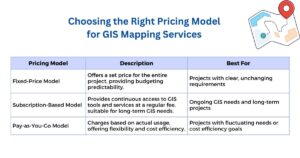The GIS market is on track to hit $14.5 billion by 2025, fueled by its growing impact across sectors like transportation, space exploration, automotive design, and smart city planning. With such explosive growth, GIS is quickly becoming indispensable for industries looking to innovate and lead.
This growth reflects that enterprises are now increasingly relying on GIS mapping services to enhance predictive modeling, optimize operations, and support strategic decision-making. As the demand for GIS solutions rises, selecting the right service provider becomes a critical focus on GIS mapping services that can offer precise geographic data to boost predictive modeling capabilities, optimize operations, and improve decision-making processes.
Companies are focusing on GIS mapping service providers who not only offer robust systems that analyze, integrate, and display spatial or geographical data but also give tailored-based services as per the project demand to achieve business objectives. In this blog, we will focus on key factors that one should look for before selecting a GIS mapping services provider.
Key Factors To Consider While Choosing A GIS Mapping Service Provider
#1 Technical Expertise and Level of Qualification
Delivering high-end GIS mapping services depends on skilled professionals who can efficiently handle GIS tools and technologies like big data handling, AI-driven geospatial analytics, etc., along with specialized projects like advanced spatial modeling. It is important to check that the service provider has a certification like GIS Professional (GISP).
#2 Data Quality and Accuracy
The data quality and accuracy are integral parts of GIS mapping as they impact the insights derived from spatial analysis. Poor-quality data can lead to increased GIS project costs and incorrect analysis, which can lead to wrong decisions.
The following factors can be checked:
- Check that the provider uses authoritative data sources and has a robust validation process, thereby maintaining quality and accuracy.
- Look for providers offering in-depth metadata with information regarding data source, accuracy level, collection data, etc. to assess reliability.
- Check whether the service provider is adhering to standards related to data accuracy set by various ISO or related bodies.
- With a dynamic technological landscape, check that the provider is offering advanced data collection tools for better quality, like LiDAR, UAVs (Unmanned Aerial Vehicles), etc.
#3 Service Offerings
While choosing a GIS mapping service provider, it is important to explore what specialized and end-to-end services are offered and how they are aligned with your goal and can help you improve results. The key services offered by a GIS provider one can look for are given below:
- End-to-end services, from the gathering of data to its processing, mapping, and final reporting for efficient project workflow, are the core services to be offered by GIS mapping service providers.
- The service provider should offer integration of GIS data with other systems, such as CRM or ERP systems, for better utilization of data in enterprise operations.
- Evaluate whether specialized services, like 3D modeling and visualization, are offered, mainly for urban planning/development and infrastructure-related projects. For projects involving customer mapping or asset management, the service provided should be able to provide geocoding and address matching.
#4 Customer Service And Training
The GIS mapping service provider should be able to offer the required customer service and training so that better utilization of GIS tools can be done to achieve the desired project outcomes. The key parameters to be looked at under the customer service and training component are
- 24/7 Customer Support Service
- Fast Response to Reduce Downtime
- Comprehensive training programs, including workshops, webinars, etc.
- Industry- or project-specific training
- Training materials such as user manuals or video tutorials.
- Effective feedback mechanism
#5 Cost Structure
While choosing a GIS mapping service provider, it is important to understand the different pricing models and how they align with your project and financial budget. In the chart below, different pricing models with key features and the right project alignment are mentioned.

Other than the pricing models, cost transparency should be maintained by the service provider by highlighting the upfront fees and hidden costs like advanced customer support, data storage requirements, etc., so the organization can effectively manage contingency expenses.
#6 Emerging Trends And Innovation Integration
Staying updated with recent trends and innovations in GIS mapping that can be implemented in your enterprise and selecting the service provider as per the requirement is crucial for informed decision-making.
Some of the latest innovations on the market are:
- Real-time analytics
- 3D GIS for better spatial visualization
- Improved predictive analytics through machine learning and AI
- Cloud-based GIS solution for scalability, better accessibility for remote teams, and flexibility
- Geospatial Data Fusion to create comprehensive geospatial datasets by combining data from social media, satellites, and other sources.
Conclusion
The selection of the right GIS mapping service provider can be complex when you want to integrate specific requirements and advanced technologies.
Evaluating the right GIS mapping service provider involves various factors, from technical qualification, customization, and integration to scalable solutions, as these factors help in making informed decisions that enhance an organization’s ability to leverage spatial information effectively.
To ease out the process, consult experts from SCS Tech India to navigate the complexities and implement innovative approaches to optimize your spatial data management and have a competitive edge in the market by leveraging GIS technologies for your projects.
FAQs
- What is the role of customer service when selecting a GIS mapping service provider?
Customer service plays an important role when selecting a GIS mapping service provider for various factors like addressing issues promptly, offering required training, assisting in technical changes, and more to enhance the overall experience. - What costs are involved in GIS mapping services?
GIS mapping services include costs such as initial setup costs, software licenses, purchasing data, customizing the system, and fees involved in continuing support and maintenance. - Are there any latest trends I should look after before choosing GIS mapping services?
Yes, the current trends in GIS mapping services one should be aware of are real-time data processing, integration of machine learning for data analysis, 3D and VR mapping technologies, edge computing, and more. - What are the core components of GIS mapping?
The core components of GIS mapping include spatial data, hardware, GIS software, and database management. Read More: Choosing Your Ideal GIS Development Platform
